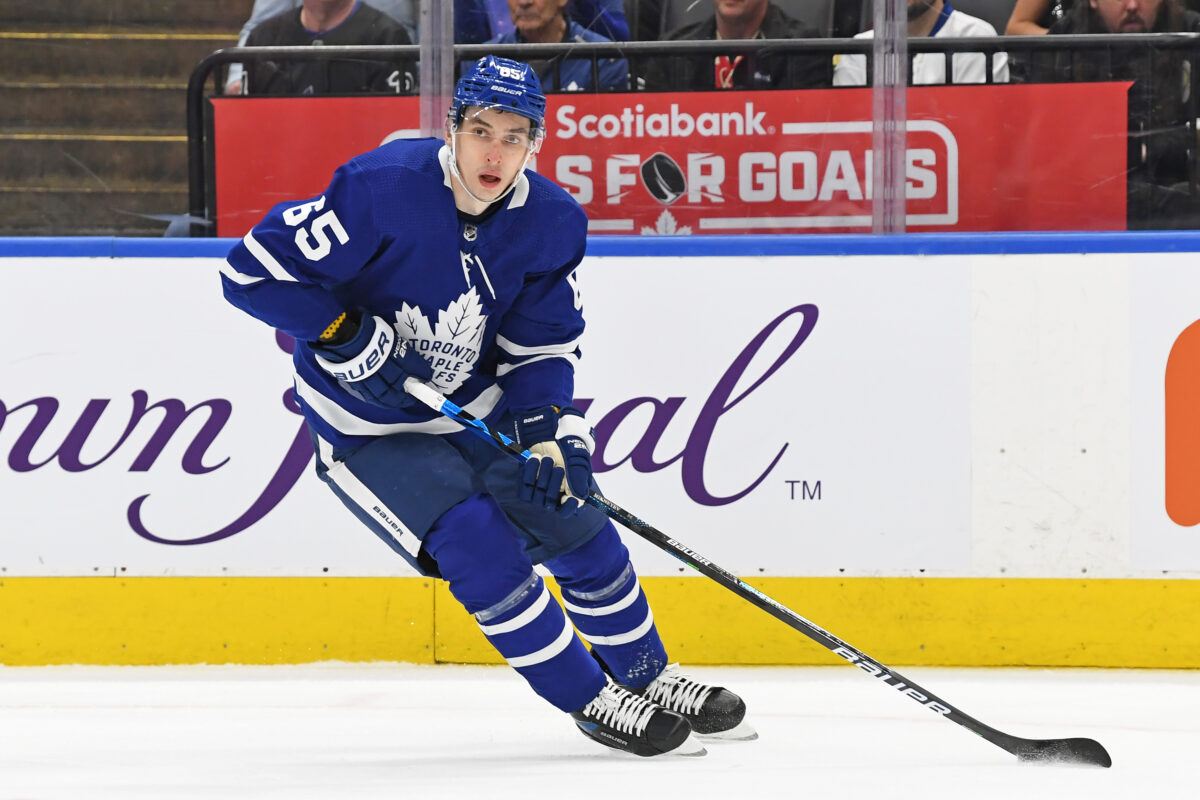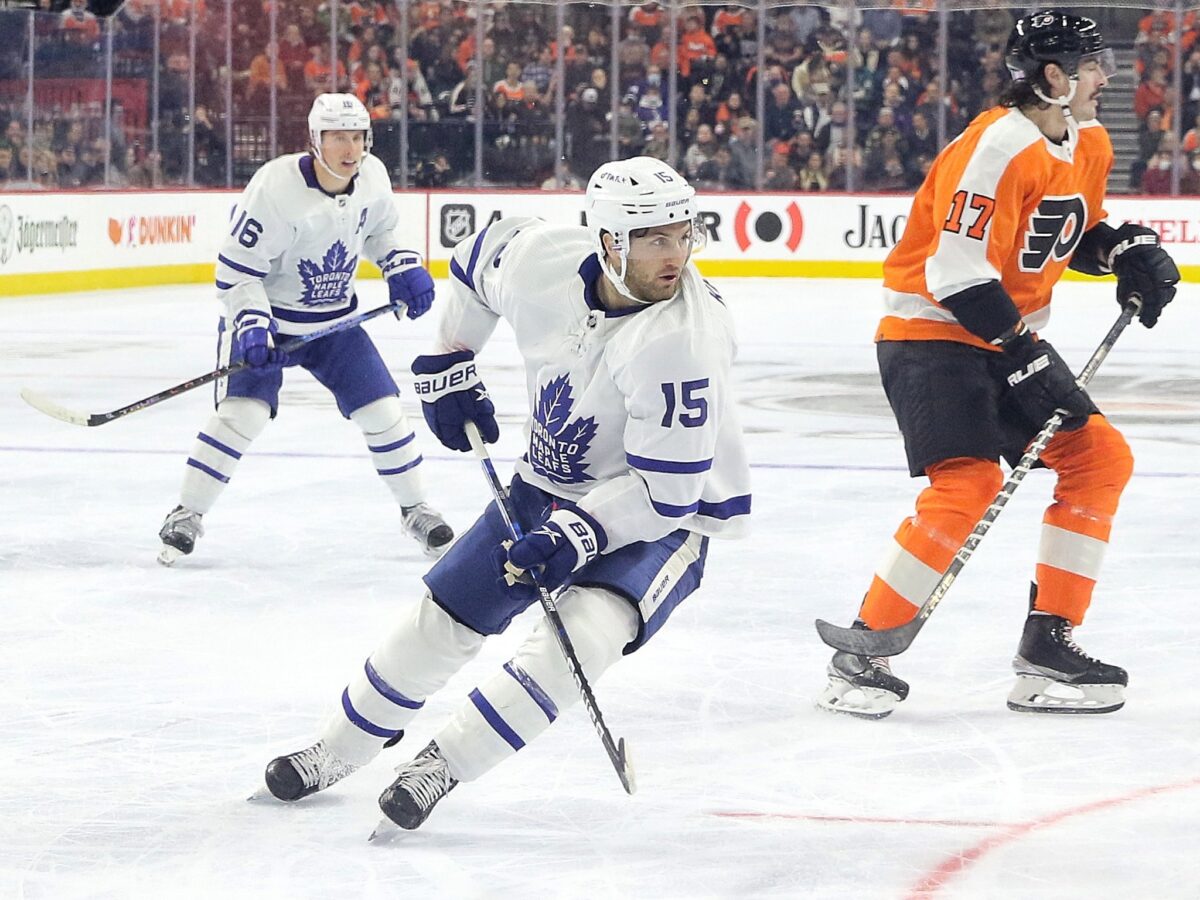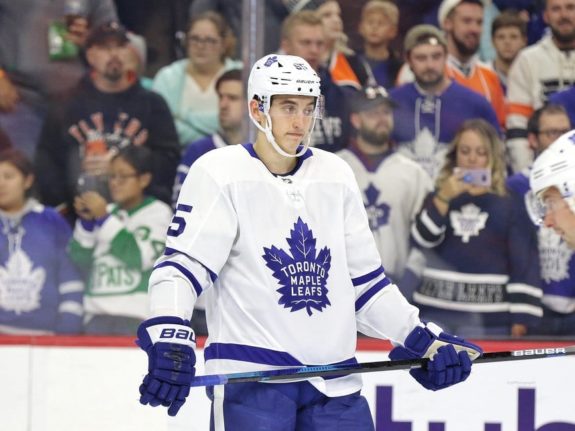The Toronto Maple Leafs have some big choices to make. Not the least of which is finding the best second-line partner for center John Tavares and winger William Nylander. In this post, we’re going to compare the two obvious choices for that role – Alex Kerfoot and Ilya Mikheyev.
Barring any trades, or any major shakeups in the way the top six lines up, putting the best winger they have alongside Tavares and Nylander is of utmost importance. Of all of the players they presently have on their roster, it appears to us the choice is to either go with the status quo and hope the 2021-22 season was just a bad one, and leave Kerfoot there, or replace him with someone else. And, should that someone else be Mikheyev?

That line did have some success with Mikheyev on the wing. He’s faster and bigger. He seems to have more of an offensive upside and is as capable defensively. Might he be a better fit on that line in the long term? With that in mind, we’ll compare the two players, in an old-school way, by looking at their traditional statistics, and in a new-age way, by looking at their analytics.
Using Old School to Analyze Player Production
| Player | Games Played | Goals | Goals per 82 Games | Points | Points per 82 Games |
| Alex Kerfoot | 82 | 13 | 13 | 51 | 51 |
| Ilya Mikheyev | 53 | 21 | 32 | 32 | 49 |
With Mikheyev coming off the hand injury and only playing 53 games, and Kerfoot playing all 82 games, we extended Mikheyev’s production to 82 games to accurately compare the two. As a result, Mikheyev’s 82-game numbers are a projection, or a “what if” scenario. We’re not sure he would have carried that pace over a full 82-game schedule. We can safely say that Mikheyev was a better goal scorer this past season than Kerfoot.
Related: Maple Leafs News & Rumors: Muzzin’s Trade & Campbell’s New Contract?
Looking at their overall points, Kerfoot comes out on top ever so slightly. Kerfoot had 38 assists in his 82 games, while Mikheyev’s projection for assists over 82 games is about 17 assists or less than half of Kerfoot’s production. That suggests Kerfoot is a better playmaker than Mikheyev. On a line with two goal-scorers like Tavares and Nylander, a playmaker who can feed them the puck might be a better fit.
The old-school way of looking at a player’s overall effect is to look at their plus/minus. Kerfoot was a plus-19 in 82 games. Mikheyev was a plus-16 over 53 games, which projects to a plus 24 over 82 games. That might suggest that Mikheyev is the better of the two defensively.

Two other defensive indicators might be hits and blocked shots. Kerfoot had 75 hits and 65 blocked shots in his 82 games. Mikheyev recorded 52 hits and 18 block shots in his 53 games. That projects to 80 hits and 28 blocked shots over 82 games.
Related: Gretzky, Ovechkin and the Goalies They Scored On (A Lot)
Despite Mikheyev being the bigger player at 6-foot-3, 195 pounds to Kerfoot’s 5-foot-10, 185 pounds, they are both about even in physicality. Kerfoot is the better shot blocker by a mile. He blocks shots at more than twice the rate as Mikheyev.
Conclusion
Looking at this old school doesn’t give us a clear winner. Each player seems to have different strengths and different weaknesses.
Using Analytics to Analyze Player Production
This analysis will break things into two categories, offensive statistics and defensive statistics. We’ll compare each player’s five-on-five on-ice numbers per 60 minutes played in six categories tracked by Naturalstattrick both offensively and defensively.
Offensive Analytics
| Shot Attempts For per 60: | Mikheyev 59.4 | Kerfoot 56.8 |
| Shots For per 60: | Mikheyev 34.8 | Kerfoot 33.5 |
| Scoring Chances per 60: | Mikheyev 32.1 | Kerfoot 30.5 |
| High Danger Chances 60: | Mikheyev 13.8 | Kerfoot 11.7 |
| Goals For per 60: | Mikeheyev 3.58 | Kerfoot 2.97 |
| Expected Goals per 60: | Mikheyev 2.77 | Kerfoot 2.51 |
Conclusion
Mikheyev was better in five of the six offensive categories. The only category where Kerfoot was better was Goals For. That could be accounted for by their line-mate’s production. Kerfoot’s most common line-mates were Tavares and Nylander, while Mikheyev’s were David Kampf and Pierre Engvall. Even with those line-mates, Mikheyev’s Expected Goals (2.77) were higher than Kerfoot’s (2.51).
Defensive Analytics
| Shot Attempts Against per 60: | Mikheyev 46.2 | Kerfoot 57.6 |
| Shots Against per 60: | Mikheyev 26.5 | Kerfoot 31.5 |
| Scoring Chances Against per 60: | Mikheyev 23.3 | Kerfoot 27.5 |
| High Danger Chances Against per 60: | Mikheyev 9.00 | Kerfoot 10.3 |
| Goals Against per 60: | Mikheyev 2.23 | Kerfoot 2.84 |
| Expected Goals Against per 60: | Mikheyev 2.08 | Kerfoot 2.41 |
Conclusion
Mikheyev’s defensive numbers were vastly superior to Kerfoot’s. If everything were equal, we would conclude that Mikheyev was the better player defensively. However, nothing is ever that black or white. As we mentioned previously, Kerfoot’s most common line-mates were Tavares and Nylander while Mikheyev’s most common line-mates were Kampf and Engvall, two very sound defensive players.
Overall Conclusion
The old-school method suggests a virtual tie. Mikheyev clearly won the advanced analysis. If we were to strictly base our decision on the analytics, we’d conclude that Mikheyev was the better candidate for that top-six role alongside Tavares and Nylander.
What We Would Do?
Mikheyev becomes a UFA on July 1st. He needs a new contract. A recent rumor from Chris Johnston suggests that Mikheyev and his team are seeking up to $5 million for their next contract. That seems high. However, if it is accurate, it seems the cookie has already crumbled. The Maple Leafs will let Mikheyev skate away.

However, a more realistic consensus given Mikheyev’s history is that he will, as a free agent, receive offers in the $3 to $4- million range. If so, that’s close to the salary Kerfoot will make for one more season.
Related: Maple Leafs Must Consider a William Nylander Trade This Summer
We know that the Tavares, Nylander, and Kerfoot combination was not a net positive overall. They scored a lot but were scored on a lot. If the 2022-23 season is a comparable season for Kerfoot, it’s conceivable he could even get a raise on his next deal. At the very least, because he’ll be a UFA the Maple Leafs could lose him for nothing.
Our thoughts are that, if the Maple Leafs can sign Mikheyev for the same salary-cap hit as Kerfoot for three or four seasons, it might be a wiser way to go. Even better if they could add a year to the deal and bring the salary-cap hit down.
Even with his injury problems, Mikheyev is a solid third-liner and a defensively-sound player. If he doesn’t work out in the top six, he’d be an asset on that third line or a tradeable asset. At the same time, Kerfoot might be a tradeable asset now who might help the Maple Leafs address other areas, such as goaltending.
At the least, we feel that retaining Mikheyev’s services over Kerfoot’s is an option that should be explored.
[Note: I want to thank long-time Maple Leafs’ fan Stan Smith for collaborating with me on this post. Stan’s Facebook profile can be found here.]
You may also like:
- Maple Leafs Assign Philippe Myers to AHL for Conditioning Stint
- Projected Lineups for the Maple Leafs vs Oilers – 11/16/24
- Maple Leafs & Penguins Could Be Perfect Trading Partners
- Maple Leafs’ Robertson & Tavares Having Very Different Paths in Toronto
- NHL Rumors: Golden Knights, Penguins, Rangers, Maple Leafs
